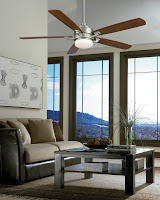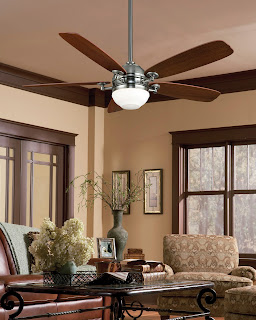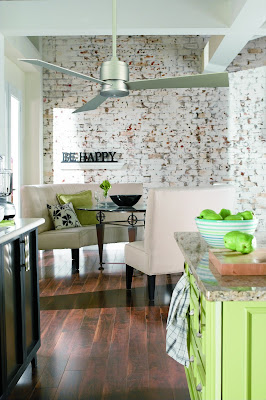Ceiling Fans - Style or Function?
Many people have lots of questions
when it comes to ceiling fans. The first think most people ask themselves is,
"do I want stylish or functional?" These days you don't have to ask
that question anymore if you choose a
fan from a reputable fan company. We consider Fanimation, Emerson, Casablanca,
Kichler, and Minka Aire reputable fan companies. These companies
make fans that can coordinate with decorative light fixtures, or can serve as both
your fan and the decorative light source in a room. Some fans offer a built-in
up-light that can indirectly light a room and create ambiance. This would be
great in a master bedroom or family room, for example. The "Landan"by Fanimation is a great example of this. Most fan controls will allow a fans
up-light and down light to be controlled separately (if applicable). There are
many unique and stylish fans available for use outdoors. Outdoor ceiling fans
have sealed motors to protect it from moisture and dirt, the blades are made of
special all-weather material to prevent cracking and warping, and the fan will
be labeled for “Damp Location”. If you add a light kit it must also be
specifically rated for “Damp Location” use. If the fan will hang in a location
where it might get wet, it must be a fan labeled “Wet Location”, and any
additional components must me rated for “Wet Location” as well. Just remember,
most fan components are not universal, so don't try to mix-and-match items from
different companies, unless the item specifically says "universal".
Some, but not many, light kits are considered universal.
 Once you see all the great fans that
are available, you then may have more questions. Like... What kind of motor do
I choose? What is Airflow Efficiency, and what does CFM mean? What is blade
pitch? How high should my ceiling fan hang? What size ceiling fan do I need? If
I hang a ceiling fan from a sloped ceiling will it hang straight? So here are
some answers!
Once you see all the great fans that
are available, you then may have more questions. Like... What kind of motor do
I choose? What is Airflow Efficiency, and what does CFM mean? What is blade
pitch? How high should my ceiling fan hang? What size ceiling fan do I need? If
I hang a ceiling fan from a sloped ceiling will it hang straight? So here are
some answers!
 For starters, you may want to determine if you want a traditional motor in your fan, or one of the new DC
motors. If price isn't the biggest factor in your decision, it's kind of a no-brainer.
The DC motor is the "Green" choice. Its built smaller and more
powerful, but with less metal for the housing and copper. A standard, or
"AC" fan motor, uses 40 to 100watts on average. The DC motor is 75%
more efficient. In other words, motors that are comparable in efficiency, the
standard motor might consume 100 watts to function on high, where as the DC
motor would only use 25 watts. The DC motor is also "whisper quiet".
When I speak to clients about their existing fans "humming", it's
actually the AC that they are listening to. With a DC motor all you will hear,
if you really listen for it, is air movement. When planning to put your fan in
a place where quiet is a must, like a bedroom, you should only consider a high
quality motor like Emerson's K55XL motor, or a DC motor.
According
to ENERGY STAR "Airflow is the rate of air
movement at a specific fan setting expressed in cubic feet per minute (CFM).
Airflow is determined from testing done using the Solid State Test Method."
Okay... in plain English please! That means all ceiling fans are tested under
the same exact conditions. Same speed, same room parameters and ceiling height, etc. Now ENERGY STAR describes Airflow Efficiency as, "the ratio of
airflow divided by power at a specific residential ceiling fan setting
expressed in CFM per watt (CFM/watt). Airflow and power are determined from
testing done using the Solid State Test Method". Again, in plain English,
it is how much power it takes to move the amount of air you need. If you truly
need a fan for cooling and heating, not just because you like the look, this
will be important. The purpose for installing a fan, or replacing one in this
case, would be to bring your energy bill down, so you will want one that doesn't
cost a lot to run quite often.
For starters, you may want to determine if you want a traditional motor in your fan, or one of the new DC
motors. If price isn't the biggest factor in your decision, it's kind of a no-brainer.
The DC motor is the "Green" choice. Its built smaller and more
powerful, but with less metal for the housing and copper. A standard, or
"AC" fan motor, uses 40 to 100watts on average. The DC motor is 75%
more efficient. In other words, motors that are comparable in efficiency, the
standard motor might consume 100 watts to function on high, where as the DC
motor would only use 25 watts. The DC motor is also "whisper quiet".
When I speak to clients about their existing fans "humming", it's
actually the AC that they are listening to. With a DC motor all you will hear,
if you really listen for it, is air movement. When planning to put your fan in
a place where quiet is a must, like a bedroom, you should only consider a high
quality motor like Emerson's K55XL motor, or a DC motor.
According
to ENERGY STAR "Airflow is the rate of air
movement at a specific fan setting expressed in cubic feet per minute (CFM).
Airflow is determined from testing done using the Solid State Test Method."
Okay... in plain English please! That means all ceiling fans are tested under
the same exact conditions. Same speed, same room parameters and ceiling height, etc. Now ENERGY STAR describes Airflow Efficiency as, "the ratio of
airflow divided by power at a specific residential ceiling fan setting
expressed in CFM per watt (CFM/watt). Airflow and power are determined from
testing done using the Solid State Test Method". Again, in plain English,
it is how much power it takes to move the amount of air you need. If you truly
need a fan for cooling and heating, not just because you like the look, this
will be important. The purpose for installing a fan, or replacing one in this
case, would be to bring your energy bill down, so you will want one that doesn't
cost a lot to run quite often.
Now
to blade pitch! Blade pitch is the angle, measured in degrees, between horizontal
and a ceiling fan's blades. If a ceiling fan's blade was completely horizontal
it wouldn't move any air around the room at all. The greater the blade pitch,
if backed by a powerful motor, the more air the fan has the potential to move. Functionally
speaking, we think 14 degrees or greater is ideal to produce an appropriate
level of air circulation when using a fan in both summer and winter. After all,
a ceiling fan needs to move just the right amount of air, not too much, and not
too little. A good blade pitch, a powerful motor, and variable speeds are what
you need to accomplish the right equation for good circulation in your home or
office. One more note, most manufacturers recommend a
ceiling fan hang 7 to 9 feet above the
floor for optimal air movement. A longer down rod may be purchased to bring
your fan to this height if you have a higher ceiling. Please be advised: a
ceiling fan must always be hung from a metal junction box. A plastic box will
eventually crack with the vibration of a ceiling fan and can cause the fan to
fall. Of course, we recommend having a licensed electrician install your fan,
who will be familiar with the proper junction box by sight.
You should choose a fan to fit the
size of your room. For a small area, like a bathroom, laundry room or small
home office, choose a 29 to 42 inch blade span fan. For larger rooms, such as a
bedroom, family room, living room, or kitchen, choose fans 50 inches to 54 inches in total
blade span. Generally, a 52 inch fan will help heat or cool most rooms
efficiently. If your room is very large,
you can use either multiple 50-54 inch fans, or one very large fan 60 inches or
greater. In the summer, when you want to cool your room, a ceiling fan should
turn counter clockwise to create a breeze. In the winter, or when you want to
help heat a room, it should be set in the reverse position (clockwise) to
circulate the hot air that rises back down to the floor. NOTE: if your fan is
specifically to help heat your room due to a high ceiling, your fan should
ideally hang 3 feet down from the ceiling in order to efficiently push the hot
air back down into the room when functioning in reverse. If a fan hangs from a
sloped ceiling, and the slope is less than 30 degrees, the fan should hang straight.
Be sure that the placement of the fan on the slope will allow adequate room for
the blades. A down rod of 18 inches usually takes care of this issue.
Most manufacturers make an optional sloped ceiling adapter for ceilings that
have a steeper slope.
For
more information, or help making your home or office a more beautiful space,
contact us. The Home
Lighter Inc. Family owned and operated since 1969.

 Once you see all the great fans that
are available, you then may have more questions. Like... What kind of motor do
I choose? What is Airflow Efficiency, and what does CFM mean? What is blade
pitch? How high should my ceiling fan hang? What size ceiling fan do I need? If
I hang a ceiling fan from a sloped ceiling will it hang straight? So here are
some answers!
Once you see all the great fans that
are available, you then may have more questions. Like... What kind of motor do
I choose? What is Airflow Efficiency, and what does CFM mean? What is blade
pitch? How high should my ceiling fan hang? What size ceiling fan do I need? If
I hang a ceiling fan from a sloped ceiling will it hang straight? So here are
some answers! For starters, you may want to determine if you want a traditional motor in your fan, or one of the new DC
motors. If price isn't the biggest factor in your decision, it's kind of a no-brainer.
The DC motor is the "Green" choice. Its built smaller and more
powerful, but with less metal for the housing and copper. A standard, or
"AC" fan motor, uses 40 to 100watts on average. The DC motor is 75%
more efficient. In other words, motors that are comparable in efficiency, the
standard motor might consume 100 watts to function on high, where as the DC
motor would only use 25 watts. The DC motor is also "whisper quiet".
When I speak to clients about their existing fans "humming", it's
actually the AC that they are listening to. With a DC motor all you will hear,
if you really listen for it, is air movement. When planning to put your fan in
a place where quiet is a must, like a bedroom, you should only consider a high
quality motor like Emerson's K55XL motor, or a DC motor.
For starters, you may want to determine if you want a traditional motor in your fan, or one of the new DC
motors. If price isn't the biggest factor in your decision, it's kind of a no-brainer.
The DC motor is the "Green" choice. Its built smaller and more
powerful, but with less metal for the housing and copper. A standard, or
"AC" fan motor, uses 40 to 100watts on average. The DC motor is 75%
more efficient. In other words, motors that are comparable in efficiency, the
standard motor might consume 100 watts to function on high, where as the DC
motor would only use 25 watts. The DC motor is also "whisper quiet".
When I speak to clients about their existing fans "humming", it's
actually the AC that they are listening to. With a DC motor all you will hear,
if you really listen for it, is air movement. When planning to put your fan in
a place where quiet is a must, like a bedroom, you should only consider a high
quality motor like Emerson's K55XL motor, or a DC motor.



No comments:
Post a Comment